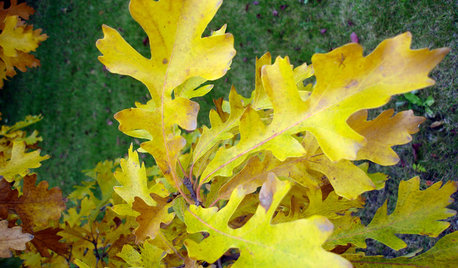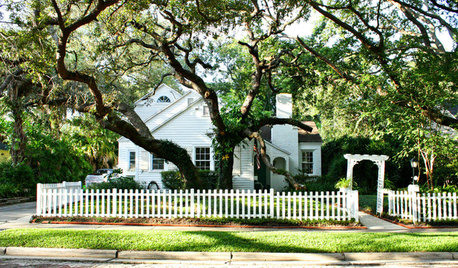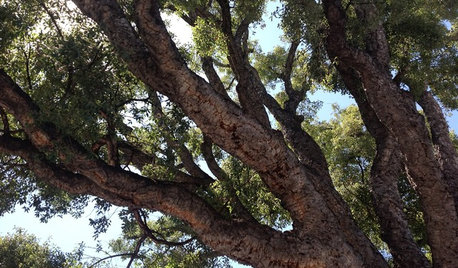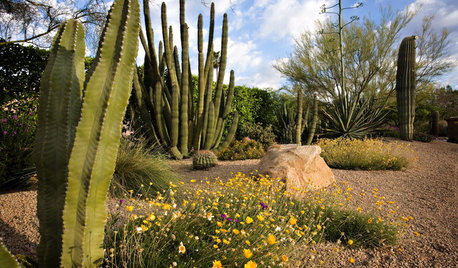Moved a 50-60' tall Oak Tree
We moved a 50-60' tall Oak tree this past Sunday from the rear of our property to the front. Unfortunately, we couldn't do it in November or December when the sap was down. We're in southern Louisiana and have had one of the coldest winters in many years so I'm hoping we got it moved before the sap started rising.
We moved it in the afternoon, watered it in very well, and it rained all day yesterday and last night. I'll keep it watered all through this year for it to get re-established. No fertilizer.
Is there anything else I should do to help it make the transition?
I'm not sure what type of Oak it is but it is not a Live Oak. The leaf is long and narrow, the same shape as a Live Oak but about twice the size. The branches do not spread out like a Live Oak but it was dwarfed by 3 tremendously tall Pine trees.
Comments (71)
brandon7 TN_zone7
14 years ago"kntryhuman, please post a 1-year update."
A 1-year update won't necessarily tell the whole story, either way (unless of course it's completely dead by then). The tree may have enough stored energy to put up a fight.
I really hope it makes it. I think it would be cool if it did, but I sure wouldn't bet any money on it. It will really be interesting if kntryhuman post a picture of a perfectly healthy tree with new growth in say three or four years from now.
kntryhuman
Original Author14 years agoLOL, my son was driving the dozer. The Bradford Pear is very old and larger than any I've ever seen. He wanted to push it over just for something to run over with the dozer when we first got it.
I may have done something stupid but I usually have very good luck with moving things. My son tied a rope around 2 large Hibiscus shrubs and 3 other bushes and yanked them out of the ground with his pick up. My MIL wanted them removed and thrown away. I planted them in the heat of La summer last year and all of them are doing well. The 2 evergreens are growing and the other 3 are starting to leaf out.
I'm holding out hope that the tree will live.
Related Professionals
Bristol Landscape Contractors · Rosemount Landscape Contractors · Southbury Landscape Contractors · Thonotosassa Landscape Contractors · Wilton Landscape Contractors · Baileys Crossroads Landscape Contractors · Downers Grove Siding & Exteriors · Lansing Siding & Exteriors · Shorewood Decks, Patios & Outdoor Enclosures · Boston Decks, Patios & Outdoor Enclosures · Lebanon Decks, Patios & Outdoor Enclosures · Medford Decks, Patios & Outdoor Enclosures · Montgomery County Decks, Patios & Outdoor Enclosures · Pittsburgh Decks, Patios & Outdoor Enclosures · South Lyon Decks, Patios & Outdoor Enclosuresbrandon7 TN_zone7
14 years agoIforgotitsonevermind,
Surely you're not besmirching one of America's most favorite trees! hehehe >:)
Embothrium
14 years agoI also wonder about all that driving back and forth over the site, not just how it is affecting the oak but also the pines etc. Vehicles should not be driven over the roots of trees that are intended to be retained in good condition.
For some background on all the factors involved in tree transplanting and preservation, what you can and cannot expect to get away with see if you can get a look at a copy of this one at a college library or elsewhere near you.
Here is a link that might be useful: Establishment and Maintenance of Landscape Plants II
stormz4
14 years agoI don't want to be a kill joy here, but this is very close to the house. Am I correct that the tree was moved from the area that it was growing naturally? It with stood some strong winds after planting? I agree it is a lovley spec. Good Luck, I'm looking forward to future postings to see how this baby does! Wow!!!
kntryhuman
Original Author14 years agoThe only trees near where the machines were being driven continually, before the tree was ever moved, are a few scrub Pines that are going to be removed. They are very tall and thin along the road. The machines were not really run over them a lot. We smoothed out sand that we moved from a pond we dug. This was done with the tractor and not the dozer. The track hoe tracks you see are from moving and planting the tree. It has been very wet here and the top layer is clay so it gives the impression that the ground is hard and packed. It is not. Trust me. We just dug a pond and had to line it with 2' of clay because the soil is sandy clay, even 15' down.
Yes, this tree was was growing naturally behind the house. We made a clearing around these Pines and where this tree was growing many years ago. The machinery was not continually run over the roots of any of the trees
kntryhuman
Original Author14 years agoMaybe I should mention the reason I'm optimistic about the tree surviving.
During Hurricane Katrina, we lost 26 Pines over 100' tall. There were many other large ornamental and fruit trees that were down. Among those were 4 Willow trees that were down. 2 of them were at least 25' tall, one Weeping and one Corkscrew Willow. These trees were not dug up. They were literally ripped out of the ground and carried many feet from where they originally stood.
My husband is disabled and my boys were working the storm so I cut up Pine trees and hauled them to the street for 3 months. After digging my trees out of the mess and clearing their "home", I tied them to my truck and drug them back and replanted them in their original holes. They were not planted very deep, I had to cover them with new soil because I had no way to dig a new hole.
Every tree is still living and growing today, almost 5 years later. Granted, this happened at the end of the growing season but these trees had very little root and were uprooted for 3 months before being replanted.
I'm optimistic!
Dan _Staley (5b Sunset 2B AHS 7)
14 years agoI'm with brandon here. It would be nice if it fought through this harsh disrespect, but very surprising and I hope that guy makes it after the brutal treatment it got.
Those ropes have to be fixed to not damage any more bark beyond the too much damage already present, and the root zone needs to be made more receptive to water infiltration. And I agree that one year won't tell the tale, two will be somewhat indicative but the multiple unnecessary and careless trunk wounds will be its ultimate downfall if it somehow survives.
-----------------
I repeat for lurkers: do NOT transplant any tree this way. Zero. Don't even think that its remotely OK how this poor thing was treated. Use this as an example of how not to do it.
Dan
lou_spicewood_tx
14 years agoGood Luck! Hopefully, you won't see another Katrina anytime soon. I've seen what Ike can do to Houston. What a mess...
rhizo_1 (North AL) zone 7
14 years agoIt only takes a little bit of track hoe activity to do permanent damage to the root/soil system. 15 minutes (or so) is all you need. Or less.
Brandon, my apologies to you...I was absolutely positive that our original poster typed in the dimensions incorrectly. It is has certainly happened a number of times before, in this forum.
I find myself somewhat transfixed by the actual scenario!
Get a 4 inch layer of bark mulch down on the entire root/soil zone and more. Do not allow any traffic, foot or otherwise in that area. Foot traffic may even be harder on the soil and root system than the darned track hoe!
Good luck and keep us informed. I would expect this tree to begin declining immediately, with the hot summer taking it o-u-t. There is nothing that would please us more than to have your efforts prove me wrong. I am absolutely serious about that.
kntryhuman
Original Author14 years agoThank you!
Beginning tonight (itÂs been raining since the tree was moved) I will be going to the house every night to water the tree. I already knew that needed to be done before I moved it.
I also fully expect the tree to begin showing signs of shock.
Once we move in a week or two and get settled, IÂll run my irrigation lines to the tree so it will have a steady supply of moisture. I will be putting mulch down, hopefully this weekend.
I find myself somewhat transfixed by the actual scenario! Somehow, we usually do this to people. LOL Like having this pre-Civil War house moved 13 miles to this property and totally restoring it. IÂve done most of the work myself on weekends over the past 2 years.
iforgotitsonevermind
14 years agoIt really doesn't look that complicated to me.
It might be hard to tell from the photo but it's not like this is an old tree requiring a huge soil ball. It doesn't really look 50+ feet to me but even if it is, it looks like a fairly young tree.Embothrium
14 years agoYes, none of the trees shown are as tall as indicated. But that is a side issue. The oak was still quite a large transplant.
Iris GW
14 years agoAmong those were 4 Willow trees that were down. 2 of them were at least 25' tall, one Weeping and one Corkscrew Willow. These trees were not dug up. They were literally ripped out of the ground and carried many feet from where they originally stood.
I imagine the Willow trees had some success because that particular genus does well with root re-generation. Just a thought.
Best of luck to you with this oak!
iforgotitsonevermind
14 years agoIf I had that equipment and 7.5 acres, I'd be moving trees all day long.
hunter41162
14 years agoSince everyone is an expert I would say you have a 50/50 shot of it living. I would say from picturs that tree looks to be around 50'. 50' isnt as much as some of you think it is. "Soil compaction" isnt an exact science. We have all seen trees growing in places the books say they shouldn't.. The oaks 4' from the alley in my backyard can attest to that.
"I repeat for lurkers: do NOT transplant any tree this way. Zero. Don't even think that its remotely OK how this poor thing was treated. Use this as an example of how not to do it."
Seriously? Some people sure do get worked up about someone moving his own trees. I encourage other lurkers with the resources to try it out. Like he stated, hes not out anything really other than a little time and didnt hurt anything by trying. And the poor thing comment was a bit over the top. Its a tree. Just from skimming through i did get a little "oh boy, look at this guy" feeling from the herd(rolls eyes). But you gotta expect a little of that when you move a 50' oak tree lolWith that being said, I dont know if time was an issue, I didnt catch that part. I would have waited for the tree to go dormant and yeah staked it a little more securely to metal posts seeing as how close to the residence it was. Possibly a little more rootball with tarp to keep it intact. I dont think its that bad of a job for a what the heck why not project. If it dies hes got some aged firewood already. I would have planted two :).
Mulch, water, and time is all you can do now. Some say talking to the tree will alleviate the seperation anxiety lol. joking
iforgotitsonevermind
14 years agoLooks about 30'
35' tops.I won't believe otherwise unless a photo is taken with a person or measuring pole is standing with the tree.
Dan _Staley (5b Sunset 2B AHS 7)
14 years agoSeriously? Some people sure do get worked up about someone moving his own trees. I encourage other lurkers with the resources to try it out. Like he stated, hes not out anything really other than a little time and didnt hurt anything by trying.
No one here, AFAICT, is worked up over the premise.
And I appreciate the opportunity to restate in yet another way for folks coming here on a search: this is the wrong way to move a tree.
The {{gwi:333634}} as a result of the move is the clue. The bark damage is unnecessary and will make it that much harder for the tree to recover as these injuries are openings for pathogens and insects to attack the weakened, stressed tree.
Presumably the tree is wanted in that spot, so care should be taken to ensure it lives, else there will me that much more time that there is no tree in that spot if it dies.
I urge folks who are considering transplanting a large tree to do the appropriate, extensive research needed to ensure a good chance of success.
Dan
jqpublic
14 years agoI'm nervous about the proximity of the tree to the house given that it is a transplant. I hope it doesn't blow over! Good luck!
Toronado3800 Zone 6 St Louis
14 years agoThe only negatives I can think to folks doing it themselves are:
1 a tree dies after investing time in moving it.
2 much worse, the tree isn't secured right and falls on their house.
Think of it this way, what if the tree has a 50% chance of survival after moving but a 0% of survival where it was in the way of a planned garage or whatever.
lsu27
14 years agoI have seen this done before to a Live Oak that was about 30 feet tall. It did look poorly for about two years, but has been 5 years since it was transplanted and it looks good. It was growing next to two very huge Sycamore trees, so my neighbor dug it up the same way you guys did and put it in front of his house. He thought he was going to bulldoze those Sycamore trees down, but the bulldozer couldn't knock them down, so he had to cut them down. So yes your tree can survive, but may take it a couple of years to get established. Since your in S. Louisiana, which according to most hardiness maps is a zone 9 not 8, the only thing you probably need to worry about is hurricanes this coming up summer. I live in north LA. so don't experience the full wrath of hurricanes. I hope it makes it for ya and good luck.
katrina1
14 years agoWow, lots of replies since your March 2 post.
This may have been answered already, but might your transplanted? oak tree be a one of your native, water oak varitieties.
Then again, just wondering how you kept the sandy soil from falling away from the large rootball once the tree was extracted and before you were able to get it into the other planting hole.
Also, if your soil is more sandy than not, I would have very little concern with compaction issues discussed above. I mean seems like the process you used to dig up and replant the tree would still leave the compacted sandy soil with conditions that a Water oak variety can withstand.
Now I am wondering though that if it is a water oak tree, you transplanted, is the new planting location going to consistantly provide the tree with enough water, even after you have babied it enough during the establishment years. You reported that your area is on a bottomland site; if the new planting hole is also on what is considered to be bottom land, then that might make my last question, mute.
Good deal how fast you indicated above that you were able to move that tree. Guess the 2010 summer's heat will be the real tester, hope your tree proves to handle that as well as you reported that it survived the high, gust-wind bursts that you listed happened during your recent storm.
jocelynpei
14 years agoA hurricane went through here in the 60's and several large trees blew over at a farm. I worked there in 75, and they lay on the lawn, part of the roots in the soil, most of the roots waving in the breeze. Because they had hired help that year, me, we all decided to pull them upright with the tractors, 2 per tree and anchor them to cables tied to a dead man anchor on the windward side of each tree. A dead man anchor is a huge log with several half hitches of cable or rope and it's buried at least 6 feet down and the sod grows back and it doesn't pull out. This is 2010, and they are still living. Keep it mulched and watered, and don't give up just yet. Expect tiny leaves due to root loss, but keep it watered and well anchored, and wait. It just might grow. It will take 4 or 5 years for enough roots to keep the leaf size normal, and to re anchor the tree.
Jocelyn, Canadaclaireplymouth z6b coastal MA
14 years agoDoes anyone have any experience with or opinions on the use of sucrose solutions to lessen transplant shock in trees? I've run into references that say it works with trees and I've used it myself with damaged houseplants. There was also a recent article in a Brooklyn Botanic Garden publication about the use of sucrose and citric acid to lessen leaf drop in houseplants brought into low light situations.
The idea I suppose is that the sugar will serve temporarily to supply carbohydrates to a plant that can't produce its own for some reason.
Claire
claireplymouth z6b coastal MA
14 years agoOh, I'm not hijacking the thread, I'm suggesting that the use of sucrose solutions might be appropriate for this oak.
Claire
Dan _Staley (5b Sunset 2B AHS 7)
14 years agoClaire, I have a colleague in Canada who over dinner a couple weeks ago was relating a story of his trip to China during the Olympics, and seeing literally hundreds of transplanted trees, all butchered up, and being injected with some sort of sucrose solution. Apparently this is rather common there. And not cheap.
Dan
claireplymouth z6b coastal MA
14 years agoWow, Dan, I wasn't thinking about injecting the poor thing - more on the line of adding a little sugar and maybe some nutrients to the irrigation water.
I wonder what the Chinese are using and whether they had long-term success after the Olympics were over.
Claire
claireplymouth z6b coastal MA
14 years agoI did a little googling and didn't find anything on China, but did find these references concerning the use of sucrose solutions during transplantation.
USE OF SUGARS TO IMPROVE ROOT GROWTH AND INCREASE TRANSPLANT SUCCESS OF BIRCH (BETULA PENDULA ROTH.)
Contract Specification for Tree Transplanting and Relocation
Excerpt from the specification:
"(c) Sugar
The backfill shall be soil injected with a sucrose solution at 20 grams per litre of water and approximately 100 litres of solution applied per tree. Soil injections of Sucrose Solutions have been shown to improve the defence systems of stressed trees and increase the volume of new roots. A qualified arboriculturist shall carry out soil injections."Claire
bushhog936
14 years agoI've read about that before and makes sense, but down here I figure it would cause a serious fire ant problem. I've given lightly sugared water to my chickens before that was stressed etc but the fire ants find it rather quick.
Dan _Staley (5b Sunset 2B AHS 7)
14 years agoPercival's work is far from complete and none of the experiments were an initial drench but rather weekly over a period of weeks. Of course if Bartlett can develop a compound that reduces transplant shock and promotes root growth in the landscape, that would be great. But at this point that's not a viable treatment. In general fertilizing (adding nutrients) after planting is bad practice; sucrose solution once is unknown.
Dan
nandina
14 years agoHaven't checked this Forum in awhile. You are having fun here! Last year I had the opportunity to visit a private plantation restoration that is very hush, hush. No pictures allowed under any circumstances. Talk about moving oaks. Rhizo, imagine the largest live oaks you have ever seen. This plantation had moved 20+ of those monsters, some dug on the plantation and others came from Florida on barges up the rivers to the plantation dock. Of course, professionals were in charge and the trees looked very healthy when I saw them. I had lots of questions but was not allowed to talk to the arborist company who were on site digging a hole ready for the next live oak installation.
Kntryhuman, press on. Several suggestions for you which some may jump all over...but, these are not going to harm your tree and may help.
Yes, mulch with a pine bark mulch. As I started reading through this thread I began thinking sugar might be helpful. If this were my tree I would do the following. Save several wheelbarrow loads of pine bark mulch. Add to each wheelbarrow load of mulch, three shovelfuls of dried molasses (can be purchased at feed stores) and five shovelfuls of the surface soil from the area from which you dug the tree. This soil should contain the natural Mycorrhizal fungus in which the oak grew. Stir all together gently and spread around the tree about a foot beyond the drip edge. Repeat with second wheelbarrow load. Also, if you are near wooded areas and can locate fallen trees with 'stump dirt' in their rotting trunks, add this to the mix. Urge you to try the above ideas even if Dan Staley sputters. Mycorrhizal fungus develops on the soil surface by cold composting of leaves/litter. Whenever one moves a shrub or tree it does no harm to gently rake a bit of the surface soil taken from the old planting spot in with the mulch of the new. Not all plants utilize it but it is a quick operation and not at all harmful. Might be useful.
whaas_5a
14 years agoWow, this thread is a trip.
Although impressive, moving a tree that big that close to a house without really knowing what kind of tree it is is just the strangest thing to me.
Dan _Staley (5b Sunset 2B AHS 7)
14 years agoUrge you to try the above ideas even if Dan Staley sputters.
I'm all for throwing native soil from nearby into the planting hole prior to placement. I do it myself and did it when I had the landscaping business. My survivorship was very high.
As for expending energy and time with molasses, the better half is teaching a Community Forester class in several weeks, and part of her curriculum is relating old crazy-sounding folk remedies from Foxfire to 'common knowledge' about trees. I already sent her the URL for this thread for giggles, I'll point her to it again for the update. Sweet!
Dan
lpalta
14 years agoHey kntryhuman, I've been causing havoc with my catalpa tree post. I love your way of getting things done--nothing ventured, nothing gained. If you don't mind reading a confusing, unintelligible, nonsensical post--I would love it if you could skim through my post and have your opinion on whether or not I can transplant the tree in question. And, any links that might be useful would be greatly appreciated.
Upstate NY Lucy
rhizo_1 (North AL) zone 7
14 years agokntryhuman, be sure to keep us up to date about your transplanting project. We'd really like to know how the tree is doing and how the rest of your landscaping is going.
kntryhuman
Original Author14 years agoThanks for asking.
As predicted, the tree died. I havenÂt posted for several reasons, mainly because of the attitude of a few of the posters here but in the meantime, I moved and have not have time to breathe.
The rest of the landscape is doing great. I dug up 3 truckloads of plants and trees from my other house and replanted them at the new house. TheyÂre all doing fine. I have to get a back hoe to dig up the rest and move them but IÂm sure theyÂll do fine.
Iris GW
14 years agoI am sorry to hear this. Certainly wished it would've made it!
Good luck with the new place.
kimcoco
14 years agoFirst and foremost, I commend you for your efforts. Hard work, I can only imagine.
Second, don't take this the wrong way, but I've spent the last 10 minutes in my chair laughing so hard I have tears in my eyes...not because you moved the tree, but because I also followed the thought process of the first two posts, in that they believed you posted the wrong measurement, and then your original response to them.
Then, add to that, the tree didn't survive...(I'm truly sorry about the tree), ..and my fellow Milwaukeean's response about not knowing what kind of tree it was ....it's very comical, like a Jerry Seinfeld episode or something.
Anyway, I hope it's something you'll be able to laugh about some day. Before I got to the final thread, I was going to tell you to remind me not to picnic near your land or lean on your trees. LOL.
(p.s. This really isn't meant to be condescending at all). A++++ for your efforts.
kntryhuman
Original Author14 years agoThanks for the lightheartedness! I can laugh at my own mistakes, too. I'm really sorry that the tree didn't survive. I don't usually lose plants or trees. I did know it was an Oak, just not what kind of Oak!
We have 7.5 acres of trees. None of them get cut down without a really good reason. My husband and kids know better than to get any where near my trees with a dozer or chain saw without asking first.
pinballer3
14 years agoWell...I am the lurker here that Dan has been talking to during this saga. Dan, I get it. There is a difference between having the best of intentions, and having/executing the best plan. The whole operation sounded like a larger version of the OPs description of ripping some shrubs out of the ground with a truck and then getting them to grow, miraculously. Really?
kntryhuman
Original Author14 years agoI don't know what lurker you're talking about. I haven't kept up with this thread. I continue to get posts in my email and don't know how to turn it off. Most of them were deleted without reading them.
The tree was not ripped out of the ground. It was dug out however, the roots were entwined with the roots of 4 huge Pines so not all the roots could be dug out "gently". I told my son to do as little damage to the Pines as possible. He painstakingly dug that tree out as best he could.
BTW, he has pulled shrubs out of the ground with his truck that were supposed to be thrown away. I can't kill anything so I took them, babied them and they are still alive today.
Dan _Staley (5b Sunset 2B AHS 7)
14 years agoGlad to see it pinballer. Come out to Barr Lake sometime and I'll walk you around on a bird watch, full naturalist mode.
Dan
pinballer3
14 years agoKH, you can turn off GardenWeb personal e-mails in your user profile. Then you only see these posts if you log on to the website and come back to the thread.
It took guts and passion to move that tree. And you came out here looking for help (perhaps a tad late:-) to add to its chances, good for you. Maybe the next one lives, or through sharing the story with others, maybe one of ours lives.
joshrobson
10 years agoa good forum to find out all this related big and old tree removing
Here is a link that might be useful: Instant Shade, Inc.
krnuttle
10 years agoIt sounds like you did everything that you should but once done and when you realized what you had done, it was "OMG what Have I done". You came to the board for reassurance and that to paraphrase famous movies character, "To know what I absolutely know"
I hope your tree grows and prosper.
(I would not have the guts to attempt it.)
kntryhuman
Original Author10 years agoUnfortunately the tree died. I think it would have lived but was too damaged while digging it up. It was sandwiched between 2 large Pines so a lot of bark and roots were lost. The tree would have been cut down if we wouldn't have moved it.
I have moved large trees many times, not this large though, and they are thriving years later.
Toronado3800 Zone 6 St Louis
10 years agoHey man, thanks for the update. Since your post I look around the web a litttle more often for videos on large tree moving. Neat stuff.
For me w/o the proper equipment it is funny how a six foot crape myrtle seems like a big job lol.
poaky1
9 years agoKntryhuman, I just spent 2 + years thinking I could grow a Live oak "late drop" zone 7, in zone 6 Pa. It lived a full year here, but last winter had prolonged -10 F , actually 8 of these below zero days/nights. Unless the sprouts that have come up live for several years, (yes, luckily, 2 of them sprouted up from the lower trunk) unless they live I can't help but feel like a "Big Dummy" like red fox used to say. But anyways, at least5 you tried. Luckily the Laurel oak and the Water oak are fast growing. You can plant more, and they will grow quickly. Now if they were Live oaks.........



















kntryhumanOriginal Author